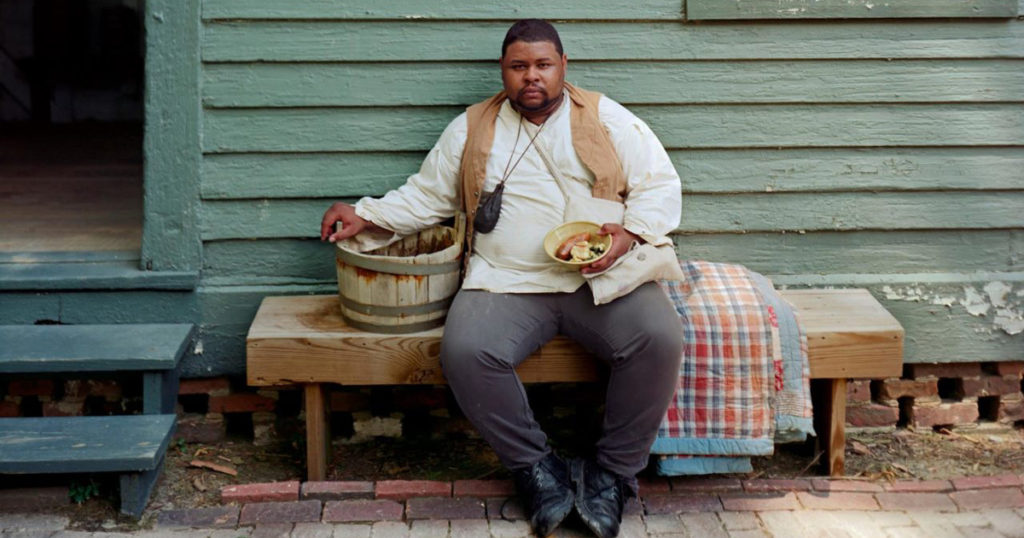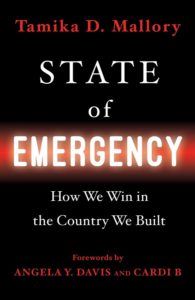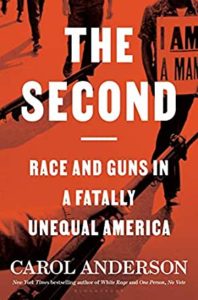What’s Cooking: Black Food History
I just started reading Michael Twitty’s The Cooking Gene, and I wanted to do more research on the history of American cuisine through the foodway journeys of African Americans.
I found this amazing gem on YouTube!

I just started reading Michael Twitty’s The Cooking Gene, and I wanted to do more research on the history of American cuisine through the foodway journeys of African Americans.
I found this amazing gem on YouTube!

 This year, I made a New Year’s resolution to read more books about subject matter I don’t know much about. I saw this book on sale during the holidays and bought it. Revolting Prostitutes looks at the current issues facing the sex workers’ rights movement.
This year, I made a New Year’s resolution to read more books about subject matter I don’t know much about. I saw this book on sale during the holidays and bought it. Revolting Prostitutes looks at the current issues facing the sex workers’ rights movement.
I found this book really interesting, accessible, and informative because it was a book about sex workers written by sex workers. Because there is so much stigma around sex work, many of the issues sex workers face get clouded with moral indignation from right-wingers and religious fundamentalists and scapegoating from so-called progressives and feminists. I don’t have a strong opinion about sex workers either way, so I read this book with an open mind. After reading it, everything about this topic made so much sense to me from the sex worker perspective.
One big thing I took away from the book is that instead of moralists always attacking sex workers, why not attack the conditions that force people to pursue this kind of work in the first place? Most people have a limited perspective of who actually does sex work. Most Hollywood portrayals of sex workers are usually privileged, cisgender white women working as high-end escorts who live a lavish life and most likely have other career options. Some people would call them the Happy Hooker or the Pretty Woman stereotype, the latter referring to the blockbuster film starring Julia Roberts.
However, the truth is far from this. The vast majority of sex workers worldwide are usually the most marginalized in society – low-income, immigrants, people of color, LGBT (specifically trans), and people with addiction and mental health problems – and their financial options are extremely limited because of stigma and discrimination. I did appreciate that the two authors, who are both white women, made it clear that they are not representative of most sex workers, and they have the privilege to write such a book when most others can’t, like a Black trans worker. Because of the stigma and discrimination, it is easy for society to look at sex work as moral indignation rather than a workers’ rights issue.
Sex work is work!
The book goes deep into many workplace issues that come up for sex workers, like police brutality, client violence and harassment, health care, housing, and the myriad of unfair labor laws worldwide. For example, it is illegal for two or more sex workers to live together in some countries because that home would be considered a brothel. Many times, sex workers find it more economical to live together. It is also safer for a worker to bring a client home so the other sex-working roommates can look out for each other if a client becomes violent. If a client does turn violent, there is no legal recourse because you can’t call the police. There is also a concern that the visiting client is an undercover cop who will arrest all the residents for brothel-keeping. The worker gets fined, but they can’t afford to pay for it. The police are usually racist, transphobic, homophobic, and xenophobic and threaten harassment, assault, and deportation. Workers will not disclose health conditions and possible assault or rape because of this fear.
The book also discusses how sex work is regulated in different parts of the world and the differences between legalization and decriminalization. The Nordic Model, or the Sex Buyer Law, basically criminalizes the client and apparently protects the worker, but most workers believe this model does more harm than good. The authors argue that when the state makes solicitation illegal, clients and workers will find other ways to get around it. It is the same argument around abortion. Just because it is illegal, that doesn’t mean women will stop getting abortions. It just means women will take more dangerous and illegal means to get them. In regards to solicitation, clients don’t stop seeking out sex workers if it is illegal. The client can take the worker far away from any potential police surveillance to a seedier location to do the transaction (like a forest or on the side of a quiet highway). The client is more likely to commit violence against the worker. Again, the worker has no legal recourse in this situation because they don’t have other financial means and fear deportation or racist cops.
Because of this, the authors argue that there should be clearer laws around full decriminalization for workers, not legalization. Legalization heavily regulates sex work, and it doesn’t prioritize the welfare of workers. In comparison, decriminalization makes sex work the default position and worker right. While it is difficult to come up with one solution to a very complex issue that is viewed differently depending on what region or country you are in, the authors conclude that there needs to be a general movement towards decriminalization, as well as better welfare and safety net provisions, freedom of movement, affordable housing, support for single mothers, better health care access, better labor rights, and access to services, work, and employment alternatives without the threat of deportation and bigotry. Most importantly, a need for rights in general, not a rescue.
“If everybody had the resources they needed, nobody would need to sell sex,” they say.
Sounds fair to me!
I highly recommend this book if you want a clear, easy-to-understand perspective from sex workers who just want respect.
 Tamika Mallory is a rising star within many social justice movements in America. She first came to prominence as a co-chair of the 2017 Women’s March with her firebrand outspokenness. More recently, she has been one of the faces of the 2020 protests when she said in a now-famous speech that George Floyd’s death wasn’t an isolated incident but really a bookmark in a long history of systemic racism. In her debut book, State of Emergency: How We Win In The Country We Built, Mallory guides readers through America’s racial history to explain why the country is indeed in a state of emergency and what can be done about it.
Tamika Mallory is a rising star within many social justice movements in America. She first came to prominence as a co-chair of the 2017 Women’s March with her firebrand outspokenness. More recently, she has been one of the faces of the 2020 protests when she said in a now-famous speech that George Floyd’s death wasn’t an isolated incident but really a bookmark in a long history of systemic racism. In her debut book, State of Emergency: How We Win In The Country We Built, Mallory guides readers through America’s racial history to explain why the country is indeed in a state of emergency and what can be done about it.
This is great for readers who might not be knowledgeable about social justice issues or don’t consider themselves activists but were radicalized by Floyd’s death and the ensuring uprisings worldwide. Rapper Cardi B asks in one of the two forwards in this book if an entertainer like herself who isn’t involved in politics has a role in the movement. Legendary activist Angela Davis answers in the other forward that entertainers have also had a role in social movements like Nina Simone and Harry Belafonte. As a matter of fact, Davis said Simone’s musicianship inspired her, and the late singer also visited Davis in jail back in the 1970s. Simone didn’t think she was educated enough to be an activist, even though today she is remembered as one of the leading voices from the civil rights movement. Davis said art moves people, and activists come into movements from different perspectives and lived experiences.
Mallory begins the book by talking about how her upbringing in Harlem, her activist parents’ involvement with Rev. Al Sharpton’s National Action Network (NAN), and her son’s father’s death inspired her activism. She then goes briefly into historical touchstones like slavery and Jim Crow laws, as well as more recent subjects like the war on drugs, the crime bill, welfare reform, and the Trump administration has led to a situation where people are protesting in the streets against police brutality and tearing down Confederate monuments and other public racist symbolism.
Mallory explains some practical issues that activists should know, like the difference between centralized and decentralized organizing, why you should pack light, and even why you should always have identification on you when you go out to a protest. I really appreciate her saying why voting is important. Often, people go to protests and don’t think to take the next step of learning more about the issues affecting their communities and voting. And not just voting, but also voting down-ballot in local elections. Mallory also takes down white women for being co-conspirators in racism and how “Karenism” has held back and destroyed black communities.
Speaking of white ladies, the only blindspot to this book was Mallory’s perspective, kind of, about her time in the Women’s March. Mallory was criticized for her association with Min. Louis Farrakhan, who has been accused of making antisemitic and homophobic at a 2018 Saviour’s Day event. Mallory was also accused of making antisemitic remarks to Vanessa Wruble, a Women’s March co-founder who is also Jewish. Wruble claims she left the organization because of concerns about antisemitism within the organization. Mallory disputed that she made the remarks to Wruble.
Although Mallory went on TV at the time to say she didn’t agree with Farrakhan on everything but didn’t directly condemn antisemitism, I think it was a missed opportunity for her to use the book to give her side of the story some clarity in her own words. Instead, she has another Women’s March co-chair and “accomplice” (Mallory’s words!) Linda Sarsour explain what really happened in a separate essay in the book. According to Sarsour, the organization, mostly led by white women, either didn’t understand or want to understand marginalized women’s issues and include their issues in the march’s platform. Every time Mallory tried to bring up these issues, she was shut down as an angry black woman. When Mallory started to gain traction in calling out privileged white women, the hate mail and death threats started to come in from detractors, who also began a smear campaign by using video of Mallory attending the Saviour’s Day event. It just seemed weird to me that Mallory used someone else’s words to describe an issue that directly happened to her.
But this is a minor issue in the book. Mallory concludes with some potential solutions to help move the country forward, like reparations and criminal justice reform. This book is definitely worth a read if you are a beginner activist looking for a roadmap.
State of Emergency: How We Win in the Country We Built by Tamika Mallory. Published by Black Privilege Publishing on May 11, 2021. Buy the book here.
 In Carol Anderson’s previous book, White Rage, she made the case for why the fight against voting rights for Black people was really a fight for white supremacy. Similarly in Anderson’s latest book, The Second: Race and Guns in a Fatally Unequal America, the author argues that the Second Amendment isn’t about protecting gun rights as NRA members like to espouse; it was designed to control and terrorize African Americans. Through her thorough research, Anderson says that gun laws and anti-Blackness were part of the founding of this country.
In Carol Anderson’s previous book, White Rage, she made the case for why the fight against voting rights for Black people was really a fight for white supremacy. Similarly in Anderson’s latest book, The Second: Race and Guns in a Fatally Unequal America, the author argues that the Second Amendment isn’t about protecting gun rights as NRA members like to espouse; it was designed to control and terrorize African Americans. Through her thorough research, Anderson says that gun laws and anti-Blackness were part of the founding of this country.
When the Haitian Revolution happened in 1791, as well as other successful anti-slavery insurrections, white slaveowners freaked out about enslaved people wanting to kill them. The Second Amendment wasn’t created for a “well-regulated militia.” It was originally a bribe to get anti-Federalists to ratify the Constitution and soothe the worries of Southern planters about slavery’s future. The Second Amendment was created to be a slave control device.
In some states at the time, Black militias, including Black slave catchers, were not allowed to carry guns. There was an argument against Black soldiers who fought valiantly in the Revolutionary and Civil Wars having access to guns. Even in southern states that didn’t have enough militiamen to fight in these wars, Black soldiers were banned from fighting simply because they would access guns. During World War I, some white people thought it would be dangerous to arm Black people and to the “racial harmony” in the country. However, it was also common at this time for Black people, including Black soldiers, to be shot and beaten because of white rage.
Nonetheless, more gun laws have been created over the years to control African Americans. When the Black Panthers carried weapons, the Oakland Police was frustrated because they couldn’t legally arrest them, as the Panthers were always operating within the laws. This all changed when California, with the support of the NRA, created Assembly Bill 1591, which made it illegal to carry loaded weapons in public and effectively outlawed the Panthers.
Anderson also talks about the hypocrisy of many of the laws still enacted today like stand your ground, open carry, and the castle doctrine, and how they affected the cases of Kyle Rittenhouse, Trayvon Martin, and Breona Taylor.
This book is an excellent primer on a current issue that has a long, unresolved history.
The Second: Race and Guns in a Fatally Unequal America by Carol Anderson, published by Bloomsbury. Buy it here.